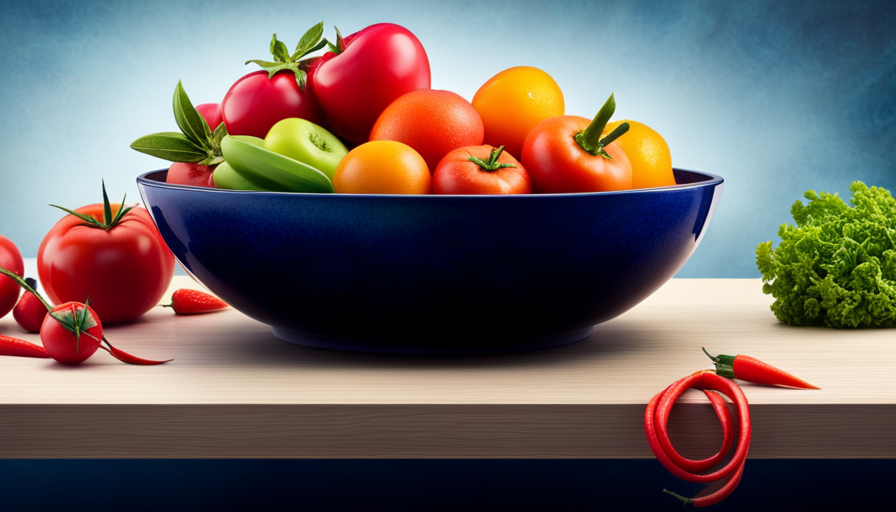Are you looking to get a brilliant smile that could outshine the sun? Search no more, as I have the key to achieving a bright white smile that will leave dentists in awe.
Brace yourself for the power of hard raw foods that will transform your dental hygiene game. These tooth-cleansing superheroes are like tiny toothbrushes, scrubbing away plaque and leaving your chompers gleaming like diamonds.
From the satisfying crunch of carrots to the refreshing snap of apples, these raw delights are packed with nutrients that not only benefit your overall health but also work wonders on your teeth. Imagine sinking your teeth into a crisp apple and feeling the natural fibers scrub away the day’s gunk. It’s like a mini dental spa treatment right in your mouth. And let’s not forget the fibrous wonders of celery and the crunchy goodness of bell peppers.
So say goodbye to dull, lackluster teeth and hello to a mouth full of radiance. Get ready to embrace the power of hard raw foods and unlock the secret to a smile that will dazzle the world.
Your dentist will thank you, and so will your mirror. It’s time to let your smile shine brighter than ever before.
Key Takeaways
- Carrots are a hard raw food that helps clean teeth due to their fiber content and vitamin A.
- Celery acts as a natural toothbrush, stimulating saliva production and helping to clean teeth.
- Nuts and seeds stimulate saliva production and reduce the risk of tooth decay, while also providing healthy fats, protein, and vitamins.
- Cauliflower acts as a natural toothbrush, promotes saliva production, and contains essential vitamins and minerals.
Carrots
Did you know that munching on carrots can help keep your teeth clean and healthy? Carrots aren’t just delicious but also packed with nutrients that promote oral hygiene. They’re a great addition to any raw food diet due to their hard texture, which helps to clean teeth naturally.
Carrots are rich in fiber, which stimulates saliva production and helps wash away food particles and harmful bacteria in the mouth. They also contain vitamin A, which supports the health of your gums and enamel. Regular consumption of carrots can reduce the risk of cavities and gum disease, keeping your teeth strong and your smile bright.
Incorporating carrots into your raw food diet can be both fun and creative. You can enjoy them as a crunchy snack on their own or incorporate them into salads, smoothies, or even homemade vegetable juices. You can also try grating or thinly slicing carrots to add a refreshing crunch to your favorite raw dishes.
Now, let’s move on to another hard raw food that can benefit your oral health – apples.
Apples
Take a bite of those crisp, crunchy apples and feel the refreshing burst of nature’s toothbrush. Apples are not only delicious but also great for your dental health. They are considered a hard raw food that helps to clean teeth naturally. Apples contain a high amount of fiber and require a lot of chewing, which stimulates saliva production. Saliva helps to wash away food particles and bacteria that can cause tooth decay.
In addition to being a natural toothbrush, apples are also packed with essential nutrients. They are a good source of vitamin C, which supports gum health and collagen production. Apples also contain antioxidants that help to fight inflammation and protect against gum disease.
To make the most of apple nutrition, try incorporating them into your everyday meals. They can be enjoyed in a variety of ways, from simply snacking on them to adding them to salads or desserts. Here are a few apple recipes to inspire you:
| Recipe | Ingredients |
|---|---|
| Apple Cinnamon Oatmeal | 1 cup rolled oats, 1 apple (diced), 1 tsp cinnamon, 1 tbsp honey |
| Waldorf Salad | 2 apples (chopped), 1 cup celery (chopped), 1/2 cup walnuts, 1/4 cup mayonnaise |
| Baked Apple Chips | 2 apples (thinly sliced), 1 tsp cinnamon |
Now, let’s move on to the next tooth-cleaning superstar: celery.
Celery
Chomp on some crunchy celery and experience the satisfying snap of nature’s dental assistant. Not only is celery a delicious and refreshing snack, but it also offers numerous benefits for dental health. When you chew on celery, its fibrous texture acts as a natural toothbrush, scrubbing away plaque and stimulating saliva production.
Saliva helps to neutralize harmful acids in the mouth and wash away food particles, reducing the risk of cavities and gum disease. To incorporate more celery into your diet for better oral hygiene, consider adding it to your salads, stir-fries, or even enjoying it on its own as a snack. You can also pair it with a healthy dip, such as hummus or Greek yogurt, for an extra burst of flavor.
Additionally, using celery as a natural toothpick can help remove any stubborn food particles stuck between your teeth. As we transition to the next section about broccoli, it’s important to note that incorporating a variety of hard raw foods into your diet can contribute to overall dental health.
So, let’s explore the amazing benefits of chewing on crunchy broccoli and how it can improve your oral hygiene.
Broccoli
Sink your teeth into the vibrant green florets of broccoli and let its crisp texture transport you to a garden of oral health wonders. Raw broccoli offers numerous benefits for dental health. It’s a hard, fibrous food that promotes saliva production, which helps to wash away bacteria and food particles that can lead to plaque and cavities. Additionally, broccoli contains vitamin C, which strengthens the gums and supports tissue repair in the mouth.
Incorporating raw broccoli into your diet is easy and delicious. You can enjoy it as a crunchy snack on its own or pair it with a nutritious dip like hummus or yogurt. Another way to incorporate broccoli into your raw food diet is by adding it to salads or stir-fries for an extra crunch.
Nuts and seeds are another excellent addition to a raw food diet for dental health. They’re also hard and require chewing, which stimulates saliva production and helps to clean the teeth. Stay tuned to discover the dental benefits of incorporating nuts and seeds into your raw food diet.
Nuts and seeds
Get ready to savor the delightful crunch and nutty goodness of nuts and seeds, as they bring a host of dental benefits to your raw food diet. While some people may have nut allergies, for those who can enjoy them, nuts and seeds provide a satisfying snack option that promotes dental health.
These hard and crunchy foods require extra chewing, which stimulates saliva production. Saliva helps to wash away bacteria and food particles, reducing the risk of tooth decay and gum disease.
In addition to their dental benefits, nuts and seeds also offer a range of nutritional benefits. They’re rich in healthy fats, protein, fiber, vitamins, and minerals. Almonds, for example, are packed with calcium, which is essential for strong teeth and bones. Sesame seeds are a great source of calcium too. Walnuts provide omega-3 fatty acids, which have anti-inflammatory properties that can benefit your gums.
Now that we’ve explored the dental and nutritional benefits of nuts and seeds, let’s transition to the next section about cucumbers. These refreshing vegetables not only hydrate your mouth but also offer additional dental benefits.
Cucumbers
Take a refreshing bite into a crisp cucumber, and feel the cool, hydrating sensation wash over your mouth while enjoying the added dental benefits it provides. Cucumbers aren’t just delicious and crunchy, but they also contribute to maintaining oral health. Incorporating cucumbers into your diet can help clean your teeth naturally due to their firm texture and high water content.
Chewing on raw cucumbers stimulates saliva production, which helps in washing away food particles and bacteria that can lead to plaque buildup and tooth decay. In addition to their dental benefits, cucumbers are also incredibly versatile in the kitchen. They can be used in a variety of recipes to add a refreshing crunch and flavor.
Try adding sliced cucumbers to salads, sandwiches, or wraps for an extra burst of freshness. You can also make cucumber-infused water or blend them into smoothies for a hydrating and nutritious beverage. As we transition to the next section about pears, it’s important to note that cucumbers are just one of many hard raw foods that can help keep your teeth clean. Pears, for example, offer similar benefits and can be enjoyed as a snack or incorporated into various recipes.
Pears
Little do people know, biting into a juicy pear not only satisfies your taste buds but also gives your oral health a surprising boost. Pears are not only delicious but also offer numerous benefits for digestion and weight loss. Here are four reasons why pears should be included in your diet:
-
High in fiber: Pears are packed with dietary fiber, which aids in digestion and prevents constipation. The fiber content also promotes a feeling of fullness, making it an excellent choice for weight management.
-
Low in calories: If you’re watching your calorie intake, pears are a great option. They’re low in calories, making them a guilt-free snack or addition to any meal.
-
Hydration: Pears have a high water content, making them an excellent choice to stay hydrated. Proper hydration is crucial for overall health and supports healthy teeth and gums.
-
Nutrient-rich: Pears are a good source of vitamins C and K, as well as other essential nutrients like potassium and antioxidants. These nutrients contribute to a healthy immune system and can help protect against chronic diseases.
To incorporate pears into a balanced diet, you can enjoy them fresh, add them to salads or smoothies, or even bake them for a warm and comforting dessert. So, next time you’re looking for a nutritious and teeth-cleaning snack, reach for a pear.
Speaking of teeth-cleaning, let’s move on to the next topic: radishes.
Radishes
Radishes, with their crisp texture and peppery flavor, offer a refreshing addition to salads and bring a delightful crunch to any dish. These small root vegetables not only add a burst of flavor to your meals but also come with numerous health benefits. Rich in antioxidants, radishes help fight free radicals in the body, reducing the risk of chronic diseases like cancer and heart disease. They are also a great source of vitamin C, which boosts immunity and promotes healthy skin. Additionally, radishes contain fiber, which aids in digestion and helps maintain a healthy weight.
When it comes to preparation methods, radishes can be enjoyed raw or cooked. Raw radishes make a great addition to salads, adding a crunchy texture and a spicy kick. They can also be pickled for a tangy and flavorful snack. If you prefer a milder flavor, try roasting or sautéing radishes, which brings out their natural sweetness.
Incorporating radishes into your diet is a simple and delicious way to improve your overall health. Now, let’s move on to another hard raw food that helps clean teeth: bell peppers.
Bell peppers
Feeling peckish? Grab some bell peppers and add a pop of color and crunch to your meals while reaping their numerous health benefits. Bell peppers aren’t just delicious, they’re also packed with nutrients that can support your overall well-being.
These vibrant veggies are a great source of vitamins A and C, which can boost your immune system and promote healthy skin. Additionally, bell peppers are low in calories and high in fiber, making them a smart choice for weight management and digestive health.
There are several ways to incorporate bell peppers into your diet. You can slice them up and enjoy them raw as a snack or add them to salads for an extra crunch. They also make a colorful addition to stir-fries, fajitas, and omelets. If you prefer cooked bell peppers, try roasting them in the oven or grilling them for a smoky flavor. The possibilities are endless!
Now, let’s move on to cauliflower, another fantastic option for promoting dental health.
Cauliflower
To maintain a healthy smile, you can incorporate cauliflower into your diet as it offers numerous benefits for dental health. Cauliflower isn’t just delicious but also a great option for promoting clean and healthy teeth.
Here are three reasons why cauliflower is a fantastic choice for oral hygiene:
-
Crunchy texture: When you bite into cauliflower, it’s firm and crunchy texture helps stimulate saliva production. Saliva plays a crucial role in neutralizing acids in the mouth and washing away food particles, reducing the risk of plaque buildup and tooth decay.
-
Natural toothbrush: The fibrous nature of cauliflower acts as a natural toothbrush, gently scrubbing the teeth and removing surface stains. Chewing cauliflower can help remove plaque and prevent it from hardening into tartar, which can lead to gum disease and tooth loss.
-
Nutritional benefits: Cauliflower is packed with essential vitamins and minerals like vitamin C, which promotes gum health and helps prevent gum bleeding. It also contains calcium, which strengthens teeth and bones. Incorporating cauliflower recipes into your diet ensures you’re getting these vital nutrients for optimal dental health.
Incorporating cauliflower into your meals is easy and versatile. You can enjoy it raw in salads, steam it as a side dish, or even use it as a low-carb substitute in recipes like cauliflower rice or pizza crust. By including cauliflower in your diet, you can enjoy its nutritional benefits while promoting a cleaner and healthier smile.
Frequently Asked Questions
Can eating raw carrots really help to clean teeth?
Yes, eating raw carrots can help to clean teeth. Carrots are a great source of fiber, which acts as a natural toothbrush and helps remove plaque and food particles from teeth. They also stimulate saliva production, which neutralizes harmful acids and promotes healthy teeth and gums. Additionally, carrots are rich in vitamin A, which is essential for maintaining strong tooth enamel. Including raw vegetables like carrots in your diet can greatly benefit your oral hygiene.
How often should I eat raw apples to maintain good oral health?
Eating raw apples regularly is key to maintaining excellent oral health. These crisp fruits act like nature’s toothbrush, gently scrubbing away plaque and stimulating saliva production. By incorporating raw apples into my diet, I benefit from their natural teeth cleaning properties.
They’re packed with essential nutrients and fiber that promote healthy gums and prevent tooth decay. So, munching on raw apples isn’t just delicious but also a smart choice for a dazzling smile.
Is celery a good alternative to brushing teeth for cleaning purposes?
Celery is indeed a good alternative to brushing teeth for natural teeth cleaning. It has numerous benefits that promote oral health. Crunching on celery stimulates saliva production, which helps to wash away food particles and neutralize harmful acids.
Additionally, the fibrous texture of celery acts as a natural toothbrush, gently scrubbing away plaque and debris. Regular consumption of celery can contribute to cleaner and healthier teeth, but it shouldn’t replace regular brushing and flossing.
What are the specific dental benefits of consuming raw broccoli?
Raw broccoli is like a dental superhero, fighting plaque and promoting oral health. Its crisp texture and high fiber content act as a natural toothbrush, scrubbing away debris and stimulating saliva production.
The abundance of vitamins C and K in raw broccoli strengthens gums and supports collagen production for healthy teeth. Additionally, the antioxidants in broccoli combat inflammation and protect against gum disease.
Incorporating raw broccoli into your diet can provide numerous dental benefits and contribute to a radiant smile.
Are nuts and seeds effective in preventing dental plaque build-up?
Yes, nuts and seeds can be effective in preventing dental plaque build-up. They contain natural oils and fibers that help to scrub away plaque from the teeth. Additionally, nuts and seeds stimulate saliva production, which helps to wash away food particles and bacteria.
Studies have shown that regularly consuming nuts and seeds as part of a balanced diet can contribute to improved oral health and reduce the risk of dental plaque build-up.
Can Cashews be Used as a Dental Chew for Dogs?
Cashews are not recommended as a dental chew for dogs due to their high fat content, which can cause pancreatitis. Instead, consider using substitutes for cashews in raw food recipes, such as apples or carrots, which provide similar crunch and dental benefits without the health risks for your furry friend.
Conclusion
In conclusion, incorporating hard raw foods into your diet can have a positive impact on your dental health. Carrots, apples, celery, broccoli, nuts and seeds, pears, radishes, bell peppers, and cauliflower are all excellent options.
These crunchy and fibrous foods can help remove plaque and stimulate saliva production, which aids in cleaning teeth naturally. So, why not take a bite out of these tooth-friendly treats and let them be your ‘time-traveling toothbrush’ that keeps your smile healthy and bright!










